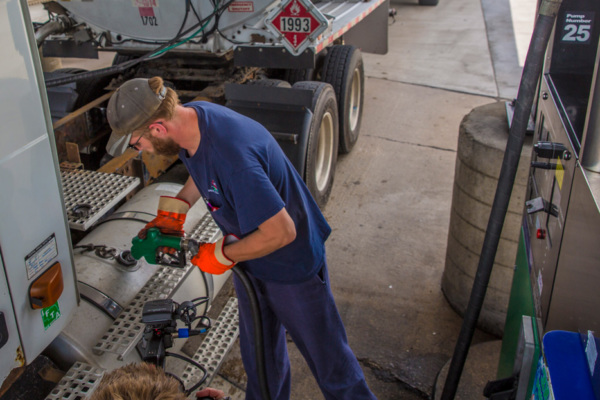Like any industry, biodiesel has its own lingo that can be confusing to a newcomer. I never want this be a barrier to learning more about how biodiesel could benefit your travel plaza or truck stop operations with its competitive pricing, strong performance and lower emissions. So I’ve provided some definitions of common terms in the biodiesel industry.
The Fuels
Biodiesel: A cleaner-burning alternative to petroleum diesel that is made from renewable resources, including used cooking oil, waste animal fats and vegetable oils.
Renewable diesel: From a chemical perspective, renewable diesel is very similar to petroleum diesel but with much lower emissions. Renewable diesel is made from the same feedstocks as biodiesel but has a different production process and meets a different specification.
Advanced biofuel: Made from advanced feedstocks like vegetable oil and recycled cooking oil, this fuel can reduce lifecycle greenhouse gas emissions by 50% or more compared with petroleum diesel. Biodiesel and renewable diesel are advanced biofuels.
The Production Proces
Feedstock: The raw material used to create fuel. For biodiesel and renewable diesel, these are renewable resources such as used cooking oil, vegetable oils and waste animal fats.
Transesterification: By reacting feedstock with an alcohol, usually methanol, manufacturers use the chemical process of transesterification to create biodiesel.
Fatty acid methyl esters: Often referred to as FAME, this is the chemical name for biodiesel. Each FAME molecule is made up of a fatty acid and an alcohol.
Distillation: The process of purifying a liquid using evaporation. Distillation is one of the ways biodiesel is purified. Distilled biodiesel has several benefits, including superior cold weather performance compared with undistilled biodiesel.
Feedstock flexibility: Only the most skilled producers can produce high-quality biodiesel from a variety of feedstocks, referred to as feedstock flexibility. This method captures each feedstock’s best properties, creates more predictable pricing and produces a more environmentally friendly fuel.
The Blends
B5, B10, B20: A fuel that is a blend of biodiesel and petroleum diesel is commonly abbreviated to a “B” and then the percentage of biodiesel in that fuel. For example, B20 is 20% biodiesel and 80% petroleum diesel.
Neat biodiesel: Biodiesel that has not been blended with another fuel. It is 100% biodiesel (or B100).
The Specifications
ASTM: This organization sets international standards for a variety of materials. The specification for biodiesel is ASTM D6751. Renewable diesel falls under ASTM D975, the diesel specification.
Cloud Point: The temperature at which wax crystals cause fuel to appear cloudy, which is one measure of cold weather performance. The higher the Cloud Point, the sooner the fuel gels.
Cetane number: A measure of a fuel’s combustion speed and a common indicator of quality. The higher the Cetane number, the shorter the ignition time. Biodiesel and renewable diesel have a higher Cetane than petroleum diesel.
Lubricity: The ability of a fuel to reduce friction and prevent wear in an engine. Ultra-low sulfur diesel has very little lubricity, whereas biodiesel has great lubricating characteristics.
The Emissions
Greenhouse gases: These gases, which include carbon dioxide, trap heat in the atmosphere and contribute to climate change.
Carbon monoxide: An odorless, colorless, poisonous gas that forms by the burning of fossil fuels. In some cities, up to 95% of all carbon monoxide emissions come from motor vehicles.
Hydrocarbons: Organic pollutants resulting from incomplete combustion of fuel. In the presence of nitrogen oxides (NOx) and sunlight, unburned hydrocarbons create ground-level ozone, which harms lungs and creates urban smog.
Particulate matter: Particulates, including solids and liquid droplets, from engine exhaust that harm the climate and human health. Fine particles can penetrate deep into a person’s lungs and even enter the bloodstream.
Put Your Knowledge to Use
Now that you know your biodiesel terminology, I hope you’ll learn more about the financial, environmental and performance benefits of biodiesel. Feel free to reach out to me with additional questions as well: troy.shoen@regi.com.
// Renewable Energy Group is leading the energy industry’s transition to sustainability by transforming renewable resources into high-quality, cleaner fuels. REG is an international producer of cleaner fuels and North America’s largest producer of biodiesel. REG utilizes an integrated procurement, distribution and logistics network to operate 14 biorefineries. REG is meeting the growing global demand for lower-carbon fuels and leading the way to a more sustainable future. Learn more about Renewable Energy Group.
Subscribe to Updates
NATSO provides a breadth of information created to strengthen travel plazas’ ability to meet the needs of the travelling public in an age of disruption. This includes knowledge filled blog posts, articles and publications. If you would like to receive a digest of blog post and articles directly in your inbox, please provide your name, email and the frequency of the updates you want to receive the email digest.


